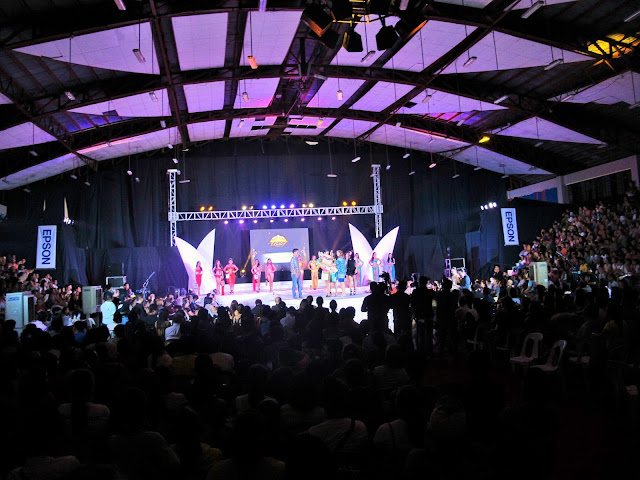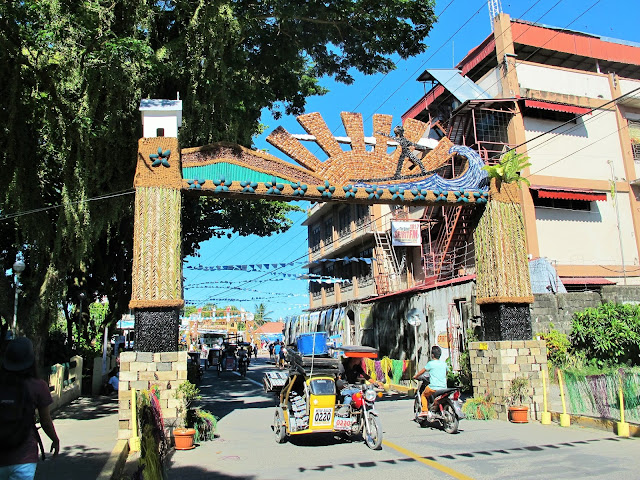 |
| Dancers from the Baler Central School enliven the street |
These are the important components of Baler’s
Coco-Sabutan Festival, which was conceptualized in 2001, keeping up with the
flourishing of festivals in the Philippines to promote tourism, to commemorate
important events and to just celebrate.
Baler’s festival
revolves about its two most important products—the coconut and the sabutan or
the thatch screwpine (Pandanus sabotan Blanco or Pandanus tectorius
Parkinson ex Du Roi).
Being in southern
Luzon, Aurora is abundant in coconut trees like its neighboring provinces such
as Quezon, Batangas and Laguna. The coconut is still a very important crop, and
2,631.6 hectares, out of the town’s total land area of 9,255 hectares, are
planted with coconuts. On the other hand, Baler takes pride in its sabutan,
whose leaves are traditionally woven into mats and hats. Recently sabutan leaves
have been fashioned into different items such as coin purses, bags, table
runners, slippers, etc. Sheets of woven sabutan are even made into gowns
to highlight this indigenous product and the many ways to innovate with it.
Neighboring town San Luis is also known for sabutan crafts and holds the
Sabutan Festival every late August.
Baler’s Coco-Sabutan
Festival is usually held from August 13 to 19 with an array of events including
a drum and lyre band competition, a women’s beauty pageant, a trade fair, and a
talent competition. This year, the festival, according to Baler mayor Nelianto
“Pilot” Bihasa, aimed to strengthen the town’s tourism industry, promote
environmental awareness and honor God, encapsulated in the theme “Sulong
Baler: Turismo ay Palakasin, Kalikasan Pagyamanin, Diyos ay Purihin”
(Forward, Baler: Strengthen Tourism, Enrich the Environment, Praise God).
A prelude to the
festival was a surfing competition. For many people outside Baler, the town is
about surfing, which is concentrated at Sabang Beach. Baler claims to be the
birthplace of surfing in the Philippines. When Francis Ford Coppola’s famous
1979 Vietnam War film Apocalypse Now was partly filmed in Baler, the
actors and crew went surfing, inspiring the locals to take on the sport after
they departed and left behind their surfboards.
Surfing has spurred
tourism in Baler, and tourism is further boosted, many locals believe, by Kris
Aquino’s featuring of the town and its premiere resort Costa Pacifica in her
show Kris TV in January 2014. A tour guide related how, after the
episode was shown, the town was deluged by visitors, testing Baler’s ability to
manage tourism. Baler has since learned from the sudden influx and is still
learning, step by step, to accommodate tourists efficiently. The surging of
accommodation, souvenir shops and restaurants in Baler indicate a positive
future in tourism.
Still developing,
the Coco-Sabutan Festival can be a major means of attracting tourists. While
mostly intended for Balerianos, the festival has a variety of events that can
attract different people.
In the last
festival, surfing enthusiasts had a field day at the Baler 406: First Baler
Surf Fest, held from August 6 to 7 at the famous tourist strip of Sabang Beach.
In the junior division, Clifford Banania emerged as champion with Neil Sanchez
as first runner-up, John Kaizer Aguila second runner-up, and Kahea Namoro third
runner-up. Meanwhile, in the men’s open division, Jefferson dela Torre surged
to championship, trailed by first runner-up Smith dela Torre, second runner-up
Wilson Faraon and third runner-up Robinson Dela Torre.
Other sporting
events included a fun run, a cycling competition, an open fishing competition,
a skateboard contest and the Palaro ng Lahi.
These “modern”
components were scheduled side-by-side traditional fiesta features such as the sayawang
bayan or town dance, where officials and senior citizens of the town’s 13 barangays
were given a venue to dance and socialize, and the making of welcome
arches.
The welcome arch
has been a ubiquitous piece of decoration during fiestas along with buntings,
which has been slowly vanishing. Reviving this festive decoration, Baler holds
a competition for the best arches. This year, private companies, civic
organizations, barangays and government agencies were grouped to form 14
teams to make 14 arches, using recycled items and indigenous materials, and
depicting this year’s festival theme. The arches were arrayed along Quezon
Avenue, the town’s main thoroughfare, infusing the town proper with a festive
air. The group that included the municipal tourism office, declared champion of
the competition, made an arch which was a composite of the iconic tourist
attractions of the town. The arch itself was also a bridge, inspired by the
Tibag-Sabang Hanging Footbridge in Zabali.
The beauty pageant
remains to be a highlight in many Philippine fiestas and festivals, and Baler
takes its beauty pageant seriously with townspeople filling Sentro Baler to the
brim on Aug. 17, the coronation night of the Binibining Baler. The barangay of
Sabang’s bet Winnie Rojo was crowned winner, while Cyrhill Renn Querijero of
Barangay 3 was first runner-up and April Adrienne Querijero of Barangay 4
second runner-up.
There have been
several shows for the entertainment of people. The amateur singing contest
Tuklas Talino, a band competition and a variety show amused audiences on
several festival nights. More interesting were the cultural ones such as the “Balintanaw:
Tanghalang Kultura” which presented an excerpt of the komedya de Baler,
a dying folk theater tradition depicting the conflict between Christians and
Moros.
A glimpse of the
town’s past was afforded by the exhibit “Baler, Noon at Ngayon,” which opened
on Aug. 15 at the Museo de Baler, one of the best museums in Central Luzon.
Mounted by an association of old families in Baler, the exhibit showed old
photographs of Baler juxtaposed with photographs of present-day Baler, allowing
viewers to see the many changes many parts of the town underwent.
Additionally,
there was a quiz bee on history and an on-the-spot painting contest for
students.
As always, the
street dancing competition remains to be the most spectacular aspect of a
festival. The Coco-Sabutan Festival street dancing parade went through the main
streets of the town proper and participated in by students.
Clad in flaming
red costume with woven sabutan accents and tiger grass plumes, the dancers of
Baler Central School was declared champion in the elementary school category
for the second year, beating A.V. Mijares Elementary School, Setan Elementary
School, Calabuanan Elementary School, Reserva Elementary School and Obligacion
Elementary School.
In the high school
category, the energetic Carmen T. Valenzuela Integrated School group rose above
the groups from Mariano L. Sindac Integrated School, Aurora National High
School, Calabuanan National High School and Baler Institute.
The following day
at dawn, August 19, a couple of school bands and the tolling of the bell
enlivened the still dark town proper. The statue of the boy bishop Saint Louis
of Toulouse was paraded in a solemn procession led by the parish priest and
several altar boys. Parishioners held lit candles, walked and prayed the rosary
until the first light of day bloomed from Baler Bay.
After the mass, a
wreath-laying ceremony at the Manuel Quezon monument at the Quezon Park was led
by the Free and Accepted Masons of the Philippines, followed by a celebratory
parade and a commemorative program at the town plaza by the municipal government.
Fireworks concluded a day of commemoration and a week of celebration.
 | |
|
 |
| The street dancing competition on August 18 |
 |
| Binibining Baler coronation night at Sentro Baler |
 |
| Perya at Sentro Baler |
 |
| Sayawang Bayan at the municipal plaza |
 |
| On-the-spot painting contest |
 |
| Hats made of sabutan |
 |
| Procession for the patron saint |







































































































No comments:
Post a Comment